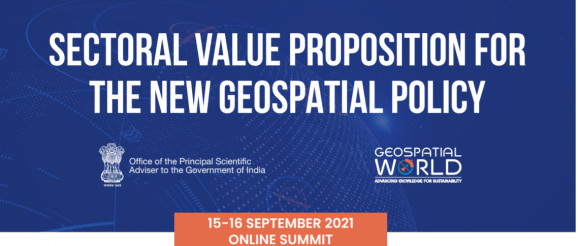New geospatial policy to open new avenues for growth, innovation – Geospatial World

The Indian government will soon come out with a comprehensive National Geospatial Policy, which is being designed in close consultation with the private industry and other stakeholders. In an online summit (Sectoral Value Proposition for the New Geospatial Policy) organized jointly by Geospatial World and the office of the Principal Scientific Adviser, Government of India, participants from public and private sectors shared their thoughts on the revised geospatial guidelines, and how a clear policy will lead to social, economic and environmental benefits for the country. “The larger idea behind the new policy is to infuse science and technology in the working of the Government of India. Geospatial information holds great significance in today’s time, and the ‘geospatial way’ is the best way to collect, process and utilize data for sustainable development,” said Dr. Arabinda Mitra, Scientific Secretary, Office of the Principal Scientific Adviser.
During his welcome address, Dr. Mitra highlighted a number of key government initiatives such as Sagar Mala project, Gati Shakti Master Plan, Svamitva project, and Smart Cities Mission that can directly benefit from geospatial data. “Locational intelligence is going to be extremely important in the future. As far as the development of the geospatial sector is concerned, India has a long way to go. The government alone cannot take up this mammoth task, and so the private sector will have to play an important part,” he said.
It’s no secret that information concerning location is an integral part of the digital ecosystem, and so, access to this information is crucial for economic growth. “The geospatial policy will soon go into the implementation mode. We already have a feedback mechanism in place and the new policy will be prepared based on the thoughts and ideas shared by the Indian geospatial ecosystem,” said Dr. K. VijayRaghavan, Principal Scientific Adviser, Government of India. The PSA emphasized on the need for location information in both traditional and non-traditional sectors of the economy.
“With the new guidelines in place, data that was earlier restricted will now be freely available to the users,” he added.
Sunil Kumar, Joint Secretary, Department of Science & Technology, said that the liberalization and democratization of geospatial data through the new guidelines has encouraged the geospatial players to explore new opportunities. “Some people wonder why the guidelines came before the actual policy. The reason is that there was a lot of clutter and confusion in the sector, and the government wanted to address that. The new policy will lay the foundation for the growth of the Indian geospatial industry, which is currently at a nascent stage,” he said.
Soon after the new geospatial guidelines were announced in February 2021, the industry had expressed confidence in the government’s intent. “The new guidelines are pathbreaking and have already created a vibrant entrepreneurial environment in the industry, which will act as a catalyst for growth and innovation in the coming years,” emphasized Ananya Narain, Director, Geospatial World Consulting. She said that the new policy will transform the industry from a service provider to a solutions provider. The Indian geospatial industry is estimated to be worth ₹50,000 crore ($500 billion) by 2025.
P V Rai, CEO, Pixel Softek, explained how the dream of a self-reliant India (Atmanirbhar Bharat) can be achieved by creating an ecosystem of companies that can compete at the global level. “Efficient and effective usage of geospatial information can contribute to almost 2% to the country’s GDP. This information reduces transportation, logistics and storage costs, and can increase farmers’ income,” he said, adding that inadequate spending on R&D can be one of the challenges for the country’s growth.
While the Fourth Industrial Revolution (4IR) is about digitalization, the next industrial revolution, or 5IR, will be about personalization. “In 5IR, nature and geography will become inseparable from human beings, and so, geospatial will assume even greater significance,” explained Agendra Kumar, President, Association of Geospatial Industries, and President & Managing Director, ESRI India. He highlighted the important role geospatial and allied technologies are already currently playing in areas like healthcare, agriculture, water resources management, among several others.
During the course of the seminar, a great deal of emphasis was laid on the government and industry coming together for better outcomes. Anal Ghosh, India Lead, Google Maps, shared a list of programs in which his company has partnered with government organizations, such as Swachh Bharat, and partnership with city traffic authorities. “We are glad that we contributed in the development of nearly 60,000 toilets, and played a part in managing traffic in busy cities like Delhi, Hyderabad and Bengaluru,” he said.
Meanwhile, G.V Sreeramam, CEO, NeoGeoInfo Technologies, stressed on the need for the private players to support and work with the government. He said, “The industry has to play a crucial part in ensuring that the new policy is a success and that we get the desired results.” Similarly, Nikhil Kumar, President Geospatial Business, MapmyIndia, cited the importance of public-private-partnerships, and highlighted the many ways in which his company has helped people in the time of Covid and even before that.
